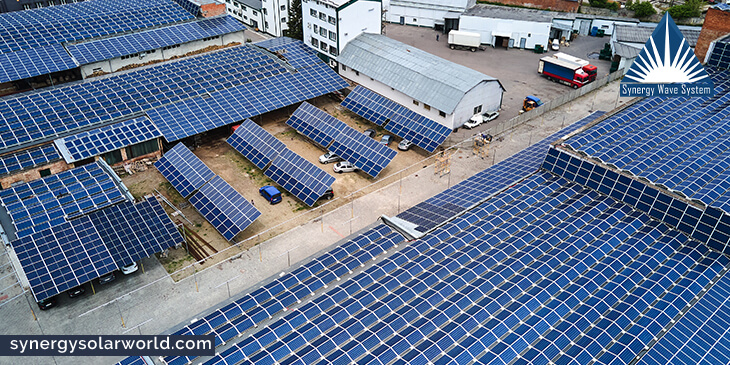Synergy Wave System

SOLAR ENERGY DEVELOPMENT – MARKET TRENDS IN INDIA 2022
SOLAR ENERGY DEVELOPMENT – MARKET TRENDS IN INDIA 2022
India as a nation is self-sustaining and thrives on its own due to the higher level of acceptance present in the country & among its people. India occupies the greater part of South Asia and is facing a severe energy shortfall that is adversely affecting its industrial growth and economic progress. The construction of new coal & oil power plants is inevitably dependent on the import of highly volatile fossil fuels, hence significantly contributing to emission of greenhouse gases, depleting the ozone layer. Looking at these dangerous residues from the fossil fuel usage, India and many other nations have turned to using renewable energy resources ie biomass, solar energy, wind energy & geothermal energy, which is environment friendly and gives us a sustainable solution to this energy crisis.
Solar energy has a massive scope of development in India, that possess geographical locations which act as an advantage for this tropical country. Almost all parts of India receive approximately 7kWh of solar radiation per square meters. Due to their geographical location, states- Andhra Pradesh, Bihar, Gujarat, Haryana, Madhya Pradesh, Maharashtra, Orissa, Punjab, Rajasthan & West Bengal have great potential to harness solar energy. Since 65.07% of the population lives in rural areas with barren & under-utilized land, there are many possibilities to promote solar energy in these areas.
When we talk about solar energy utilization, massive industrial growth has taken place over the past decades. Solar lighting systems have seen massive growth, both indoor as well as outdoor lightings. Installation of solar lights would not only save on the electricity bills, but also save the environment from harmful emissions from fossil fuels. Having said that a major chunk of the population is not ready to take the plunge as they’ve some reservations about the solar idea of power generation due to knowledge constraint.
Indian government has been committed to exploit this precious renewable solar resource to scaleup the industrial production and national economic standards. The road ahead in major market developments in the field of solar energy have been massive.
• Recent GOI initiative schemes aim at adding solar and other renewable capacity of 25,750MW by 2022 with total central financial support of Rs.34,422 crore including service charges to the implementing agencies.
• As of July 2021, India had 96.96GW of renewable energy capacity & represents 25.2% of the overall installed power capacity, providing a great opportunity for expansion of green data centres.
• The government plans to establish renewable energy capacity of 523GW (including 73GW from Hydro) by 2030.
• Solar energy market has experienced manifold developments in the field of engineering, procurement and construction contracts. Approximately 66MW are installed for various applications in the rural areas, which is equivalent to being used in solar lanterns, street lighting systems & solar water pumps, etc.
• In August 2021, installed capacity of Hydro projects in India reached to 46.41GW, while capacity of small Hydro plants reached to 4.8GW.
• Installed renewable power generation capacity has gained momentum over the past few years, posting CAGR of 17.33% between FY16-20. With the increased support of government & improved economics, the sector has become attractive from investors perspective.
• As Indian looks at meeting its energy demand on its own, which is expected to reach 15,820 TWh by 2040, renewable energy is set to play an important role.
• In the recent Paris agreement, the Indian government is committed to achieve 227GW of renewable energy capacity by next year.
• With the potential capacity of 363GW & with policies focused on the renewable energy sector, Northern India is expected to become the hub of renewable energy in India.
• The Solar Energy Corporation of India (SECI) implemented large scale central auctions for solar parks & has awarded contracts for 47 parks with over 25GW of combined capacity.
• In March 2021, India and the US agreed to restructure their strategic energy partnership to concentrate on cleaner energy sectors including biofuels and hydrogen production.
• NTPC is expected to commission India’s largest floating solar power plant in Ramagundam, Telangana by May-June 2022 with the expected total installed capacity to be 447MW.
• It is expected that by 2040, around 49% of the total electricity will be generated by renewable energy as more efficient batteries will be used to store electricity, which will further cut the solar energy costs by 66% as compared to the current cost.
• As per the Central Electricity Authority (CEA) estimates, by 2029-30 the share of renewable energy generation would increase from 18% to 44%, while that of thermal is expected to reduce from 78% to 52%.
The GOI has devoted itself to increased use of clean energy sources and is already undertaking various large scale sustainable power projects and promoting green energy heavily. Many Solar companies in Gurgaon have cropped up to seal in this renewable green resource and harness the solar energy for better electricity production. In addition, this renewable energy has immense potential to generate employment opportunities at all levels, especially in rural areas.
